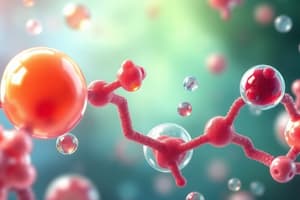Podcast
Questions and Answers
What results from the hydrolysis of the anomeric carbon in carbohydrates?
What results from the hydrolysis of the anomeric carbon in carbohydrates?
-OH bond formation.
Explain the process that leads to glycoside formation in carbohydrates.
Explain the process that leads to glycoside formation in carbohydrates.
Condensation of the anomeric hydroxyl group with another hydroxyl group, eliminating water.
What characteristics define a chiral carbon in carbohydrates?
What characteristics define a chiral carbon in carbohydrates?
A chiral carbon is connected to four different atoms or groups.
Differentiate between laevorotatory and dextrorotatory carbohydrates.
Differentiate between laevorotatory and dextrorotatory carbohydrates.
What are the potential consequences of carbohydrate deficiency in the body?
What are the potential consequences of carbohydrate deficiency in the body?
What role do structural polysaccharides like chitin and cellulose play in living organisms?
What role do structural polysaccharides like chitin and cellulose play in living organisms?
How do storage polysaccharides function in the body, and can you name two examples?
How do storage polysaccharides function in the body, and can you name two examples?
What is the significance of heteropolysaccharides in biological systems?
What is the significance of heteropolysaccharides in biological systems?
What happens to carbohydrates during the process of oxidation?
What happens to carbohydrates during the process of oxidation?
Explain the alkylation reaction in carbohydrates and name the alkylating agents involved.
Explain the alkylation reaction in carbohydrates and name the alkylating agents involved.
What are some examples of glycosaminoglycans and their functions?
What are some examples of glycosaminoglycans and their functions?
Describe how carbohydrates can be reduced and the products of this reaction.
Describe how carbohydrates can be reduced and the products of this reaction.
What is the role of enzyme amylase in relation to storage polysaccharides?
What is the role of enzyme amylase in relation to storage polysaccharides?
What are structural polysaccharides and provide one example?
What are structural polysaccharides and provide one example?
Define storage polysaccharides and name one common type.
Define storage polysaccharides and name one common type.
What type of chemical reaction is commonly involved in the formation of carbohydrates?
What type of chemical reaction is commonly involved in the formation of carbohydrates?
What are glycosaminoglycans and their primary function?
What are glycosaminoglycans and their primary function?
Explain the concept of optical activity in carbohydrates.
Explain the concept of optical activity in carbohydrates.
How are carbohydrates classified based on their size and structure?
How are carbohydrates classified based on their size and structure?
What are the two primary types of carbohydrates based on their functional groups?
What are the two primary types of carbohydrates based on their functional groups?
Give one example of a digestible polysaccharide and a non-digestible polysaccharide.
Give one example of a digestible polysaccharide and a non-digestible polysaccharide.
Flashcards
Hydrolysis of -OR bond
Hydrolysis of -OR bond
The -OR bond at the anomeric carbon breaks down to form an -OH bond.
Glycoside formation
Glycoside formation
Carbohydrates form glycosides when their anomeric hydroxyl group bonds with another carbohydrate's hydroxyl group, releasing a water molecule.
Optical activity
Optical activity
A molecule's ability to rotate plane-polarized light.
Chiral carbon/center
Chiral carbon/center
Signup and view all the flashcards
Carbohydrate Optical Activity
Carbohydrate Optical Activity
Signup and view all the flashcards
Structural Polysaccharides
Structural Polysaccharides
Signup and view all the flashcards
Storage Polysaccharides
Storage Polysaccharides
Signup and view all the flashcards
Chitin
Chitin
Signup and view all the flashcards
Cellulose
Cellulose
Signup and view all the flashcards
Starch
Starch
Signup and view all the flashcards
Glycogen
Glycogen
Signup and view all the flashcards
Heteropolysaccharides
Heteropolysaccharides
Signup and view all the flashcards
Reducing Sugars
Reducing Sugars
Signup and view all the flashcards
Biomolecules
Biomolecules
Signup and view all the flashcards
Carbohydrates
Carbohydrates
Signup and view all the flashcards
Monosaccharides
Monosaccharides
Signup and view all the flashcards
Disaccharides
Disaccharides
Signup and view all the flashcards
Oligosaccharides
Oligosaccharides
Signup and view all the flashcards
Polysaccharides
Polysaccharides
Signup and view all the flashcards
Aldoses
Aldoses
Signup and view all the flashcards
Ketoses
Ketoses
Signup and view all the flashcards
Study Notes
Basic Chemistry of Biomolecules
- Biomolecules are substances produced by cells and living organisms.
- They have diverse structures and functions.
- Small biomolecules include sugars, fatty acids, amino acids, and nucleotides.
- Major biomolecules (macromolecules) are carbohydrates, lipids, nucleic acids, proteins, vitamins, hormones, and enzymes.
Carbohydrates
- Carbohydrates are widespread organic substances.
- Their chemical formula is Cn(H₂O)n, which is also known as "hydrated carbon."
- Chemically, they are polyhydroxy aldehydes or ketones, or their derivatives or polymers.
- Common sources of carbohydrates include potatoes, maize, milk, popcorn, and bread.
- Classification is based on chemical structure and digestibility.
- Monosaccharides: simple sugars (e.g., glucose, fructose).
- Disaccharides: two simple sugars bonded together (e.g., sucrose).
- Oligosaccharides: three to six monosaccharide units.
- Polysaccharides: more than six monosaccharide units.
- Classification based on functional groups:
- Aldoses (aldehyde group, e.g., glucose).
- Ketoses (ketone group, e.g., fructose).
- Classification based on the number of carbon atoms:
- Trioses (3 carbon atoms).
- Tetroses (4 carbon atoms).
- Pentoses (5 carbon atoms).
- Hexoses (6 carbon atoms).
- Heptoses (7 carbon atoms).
- Monosaccharides cannot be hydrolyzed further.
- Glucose is also known as aldohexose and dextrose.
- Reducing sugars have a free aldehyde or ketone functional group.
- Disaccharides are composed of two sugar units joined by O-glycosidic bonds.
- Examples of disaccharides include sucrose, lactose, and maltose.
- Polysaccharides are large molecules with many monosaccharide units linked together.
- Examples include cellulose, starch, and glycogen.
- Glycogen is a branched chain of glucose molecules, stored as an energy source in animals.
- Heteropolysaccharides contain two or more different types of sugar units (e.g., hyaluronic acid, heparin).
- Chemical reactions of carbohydrates include alkylation (forming ethers) and acylation (forming esters).
Biological and Pharmaceutical Importance of Carbohydrates
- Carbohydrates are an instant energy source (4 calories/gram).
- Balanced carbohydrate intake is crucial for normal blood glucose levels.
- Excessive intake can lead to diabetes.
- Carbohydrates (sucrose, lactose, starch, gums) are used in food preparation (syrups, tablets, infant food).
- Other uses include laxatives (mucilage, lactulose), antacids/diuretics (sucralfate, mannitol, sorbitol), and culture media (agar).
- Some carbohydrates are used in drugs (streptomycin).
Other
- Optical activity of a molecule is its ability to rotate polarized light.
- Chiral carbons are carbon atoms attached to four different atoms or groups.
- Carbohydrates are generally optically active due to chiral carbons.
- Reduction of carbohydrates by sodium borohydride reduces the carbonyl group (C=O) to an alcohol.
- Oxidation of carbohydrates forms carboxylic acids.
- Hydrolysis breaks glycosidic bonds in disaccharides and polysaccharides.
- Glycoside formation occurs through condensation.
Studying That Suits You
Use AI to generate personalized quizzes and flashcards to suit your learning preferences.



